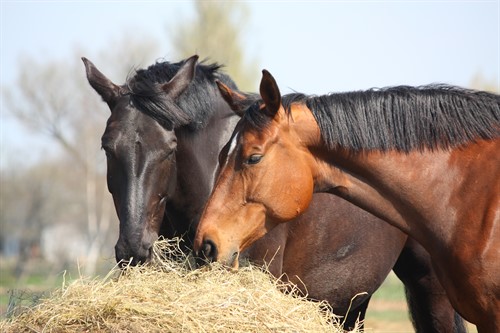
There’s nothing like the excitement of a new horse or one’s first horse. One of the most important things to consider is that horse’s diet. But where to begin? We receive many calls from horse owners who are overwhelmed, confused and downright frustrated about what to do when trying to determine what — and how much — to feed their equine companions. One size does not fit all, and each horse’s individual needs must be considered. However, there are a few basics you should know so you can head in the right direction.
How much can a horse consume?
Typically, a horse consumes 1.5-2.5% of his body weight in food per day. Say, for example, you have a horse that weighs 1,100 pounds. The math is simple (I promise!):
- 1100 x 1.5% = 16.5 lb of food/day
- 1100 x 2.0% = 22 lb of food/day
- 1100 x 2.5% = 27.5 lb of food/day
Horses with trouble maintaining weight may need closer to 2.5% of their body weight in food per day, whereas easy keepers (and certainly most ponies) will probably fare well with 1.5-2% of their body weight in food per day.
When it comes to calories, an individual horses’ needs vary widely. Think again about the 1,100-pound horse in light work, who is ridden three to four times per week for a total of about three hours. That horse needs approximately 20,000 kilocalories (what we think of as Calories) per day! By comparison, a 440-pound pony needs closer to 8,000 kilocalories*.
Most horse owners don’t count calories in equine diets. For the most part, they don’t have to if good quality forage (hay and/or grass) and concentrate feed, when necessary, are provided.
Forage First
Horses evolved eating frequent, small forage meals throughout the day, and thus evolved on a forage-based diet. Always begin with forage. When starting with a new diet, try to get some of the hay a horse has been eating from wherever the horse is coming from. Remember, all hay is not the same. Just like when changing concentrates, bringing new hay into the diet should also be done gradually. (Yes, even when you order your next load of hay, or travel to a horse show!)
If the horse easily maintains weight, use the above body weight guide to weigh out an appropriate amount of hay and provide a ration balancer such as GRO ‘N WIN™ or Senior Balancer. Ration balancers will ensure nutrient needs are met, regardless of what may be missing in the hay, without providing extra calories.
Horses that can’t maintain weight on hay alone may need a grain concentrate, such as EQ8™, CADENCE™ Ultra or SAFE ‘N EASY™ Senior, to help supply enough calories. Guidelines on how much concentrate to feed are provided by the manufacturer, based on the horse’s ideal body weight. Remember to feed the horse based on the weight you want him to be.
BUCKEYE Nutrition carefully crafts feeding directions based on the concentration of nutrients and calories of each product — we’ve done the hard work for you. Our nutritionists all have advanced graduate degrees in equine nutrition, and can help guide your through feeding recommendations based on your horse’s needs. Reach out to our equine nutritionists today.
*National Research Council. 2007. Nutrient Requirements of Horses, 6th Edition. National Academies Press, Washington, DC.